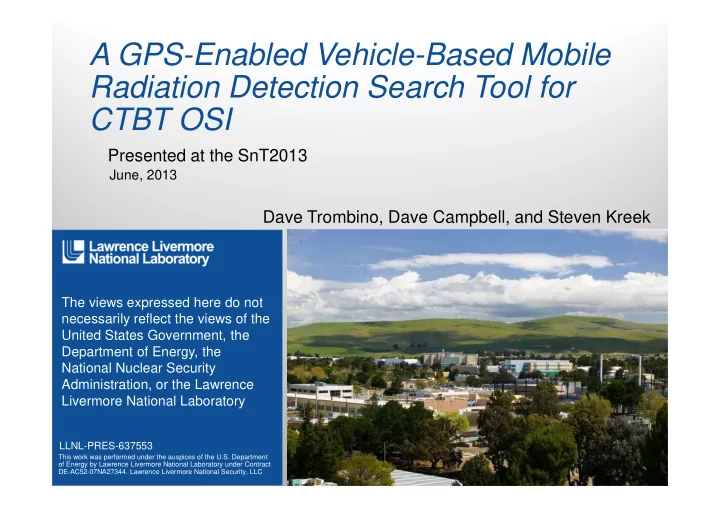

A GPS-Enabled Vehicle-Based Mobile Radiation Detection Search Tool for CTBT OSI Presented at the SnT2013 June, 2013 Dave Trombino, Dave Campbell, and Steven Kreek The views expressed here do not necessarily reflect the views of the United States Government, the Department of Energy, the National Nuclear Security Administration, or the Lawrence Livermore National Laboratory LLNL-PRES-637553 This work was performed under the auspices of the U.S. Department of Energy by Lawrence Livermore National Laboratory under Contract DE-AC52-07NA27344. Lawrence Livermore National Security, LLC
OSI will initially focus on search area reduction - applying multiple techniques Sampling Field In Situ assay Active seismic Aerial overflight …. Conductivity Backpacks Laboratory assay Position keeping Support equipment Radar Lawrence Livermore National Laboratory 2 LLNL-PRES-xxxxxx
Application of radiation detection to OSI is likely to be challenged by a number of issues including: � Potential for highly variable/unknown source terms � Harsh operational environments complicated by instruments that are: • Hard to use, often proprietary • Difficult to maintain • Competing with other inspector responsibilities Lawrence Livermore National Laboratory 3 LLNL-PRES-xxxxxx
OSI needs mobile gamma detection capability with some key attributes…. � Flexibility, and scalability for highly-variable environments • Operating • Activity ranges � Ease-of-use • Multi-mode acquisition/data display • Open for international use, non-proprietary control and output • Supportability • Data recording and/or transmission/retrieval including location Lawrence Livermore National Laboratory 4 LLNL-PRES-xxxxxx
The Lawrence Livermore National Laboratory has a long history of solving radiation detection challenges 2005: Adaptable Radiation Area Monitor Detective (HPGe) 2006: UltraSpec Fission Meter 2007: Large Area Imager 2009: GeMINI 2010: SrI 2 2010: SRaDS, Statistical Radiation Detection System Software 2012: PSD Plastics Next-gen high-resolution HPGe detector (GeMini) 2008 Adaptable Radiation 2009 Area Monitor 2005 Lawrence Livermore National Laboratory 5 LLNL-PRES-xxxxxx
Next-gen materials promise improved performance and lower cost First-ever organic plastic scintillator SrI 2 offers better gamma with pulse-shape discrimination energy resolution…. Lawrence Livermore National Laboratory 6 LLNL-PRES-xxxxxx
As a leveraging opportunity, we are evaluating technology developed for mobile search � Our regional security pilot in San Francisco Bay is field testing detection technologies, advanced communications and reach back Oleg at NPS � Partnership between LLNL, Naval Video from Detector Data field Post Graduate School and a SF Bay Regional Coalition Fielded with multiple organizations, the LLNL-developed detection systems have been operational for a number of years Lawrence Livermore National Laboratory 7 LLNL-PRES-xxxxxx
We’re testing operational concepts and advanced reachback on a regional (larger than an inspection area) scale � Multiple technologies � Harsh and real operational environments • Sea and land based implementations System layout courtesy of Naval Post Graduate School Lawrence Livermore National Laboratory 8 LLNL-PRES-xxxxxx
Specific focus is on an LLNL-developed mobile detection/screening system � Real-time radiation monitoring system with scalar and spectral data display to enable decision-making � Operational with multiple users � Real-time reachback and analysis support Lawrence Livermore National Laboratory 9 LLNL-PRES-xxxxxx
Tech Specs of the detection system � NaI(Tl) Detector • Active volume — Three sizes: 4x4x4, 2x4x16, 4x4x16 demonstrated — Including ganging as many a 4 detectors • Energy resolution: typically 6-8% at 137 Cs � Environmentally hardened � Optional embedded communications � Power requirements • Operates off PC laptop battery � Operating software (next slide) � GPS (external and/or removable) Lawrence Livermore National Laboratory 10 LLNL-PRES-xxxxxx
Data is collected and displayed in multiple modes Scalar count rate Spectral histogram 137 Cs & 60 Co Counts Channel Lawrence Livermore National Laboratory 11 LLNL-PRES-xxxxxx
Operating interface designed for ease of use…. � Windows-based (7+) C-Sharp code operating Ortec- based acquisition hardware (digiBase) � Provides for simple operation • Starts/Stops acquisition • Reports relative scalar rates and an alarm threshold • Tracks GPS location • Provides spectral display — Continuous or limited duration acquisition, clearable to the user, and can be enabled or disabled • Data saved locally w/ or w/o transmission, both data push and pull available (if networked) — Saved in ANSI Standard file format for easy import Lawrence Livermore National Laboratory 12 LLNL-PRES-xxxxxx
A couple of short demonstrations � Video of a system in operation around San Francisco Bay Area � Example of data capture and data upload over our mesh network Lawrence Livermore National Laboratory 13 LLNL-PRES-xxxxxx
Field demonstration using an early prototype Lawrence Livermore National Laboratory 14 LLNL-PRES-xxxxxx
Upload and reach back demo Oleg at NPS Video from field Detector Data Lawrence Livermore National Laboratory 15 LLNL-PRES-xxxxxx
Numerous demonstrations have been performed � Locations around the world Lawrence Livermore National Laboratory 16 LLNL-PRES-xxxxxx
System is operated on a boat Lawrence Livermore National Laboratory 17 LLNL-PRES-xxxxxx
Close up of approaching target Lawrence Livermore National Laboratory 18 LLNL-PRES-xxxxxx
Radioactive source is located � Picture and spectrum returned to reachback Lawrence Livermore National Laboratory 19 LLNL-PRES-xxxxxx
Data is analyzed locally or can be pushed by the user to reachback Lawrence Livermore National Laboratory 20 LLNL-PRES-xxxxxx
Conclusions � Demonstrated a flexible radiation detection system that is scalable and could support a wide variety of OSI operational environments � Developed and operating - using currently available commercial hardware Lawrence Livermore National Laboratory 21 LLNL-PRES-xxxxxx
Contact Steven Kreek Lawrence Livermore National Laboratory kreek1@llnl.gov Lawrence Livermore National Laboratory 22 LLNL-PRES-xxxxxx
Recommend
More recommend